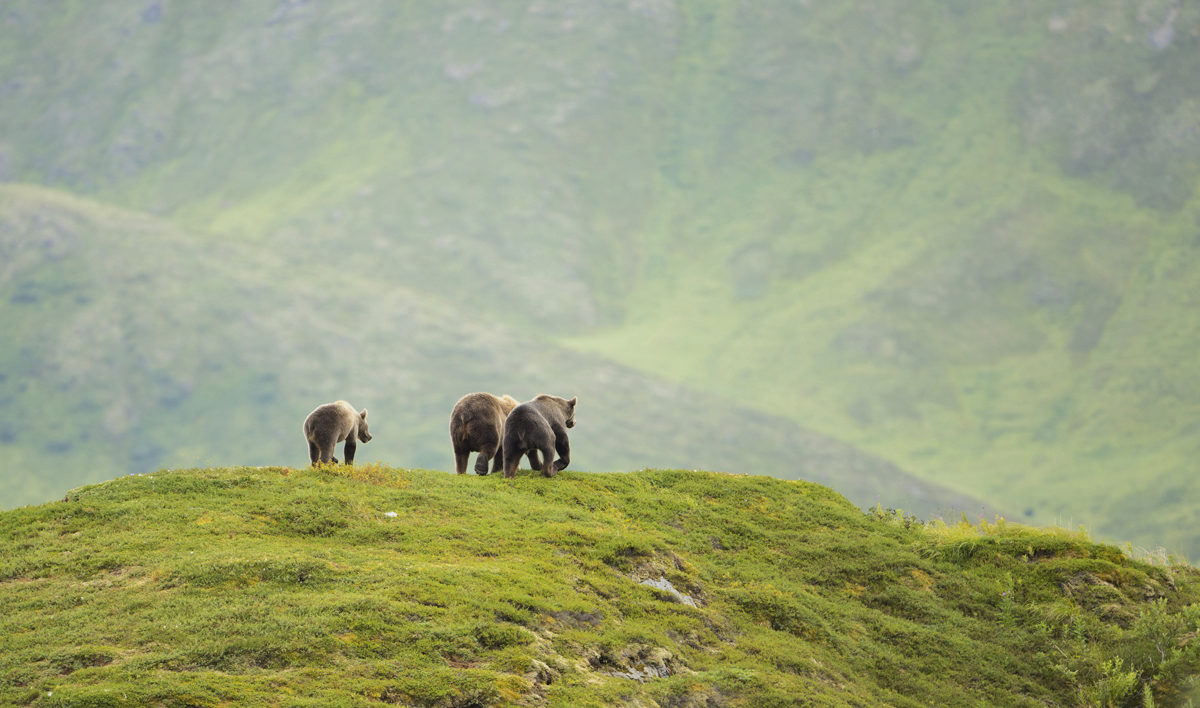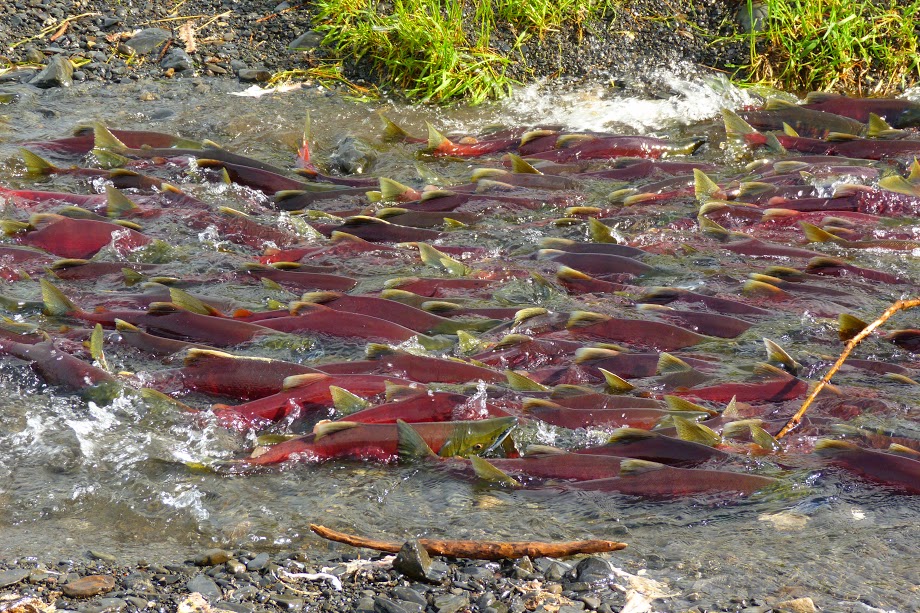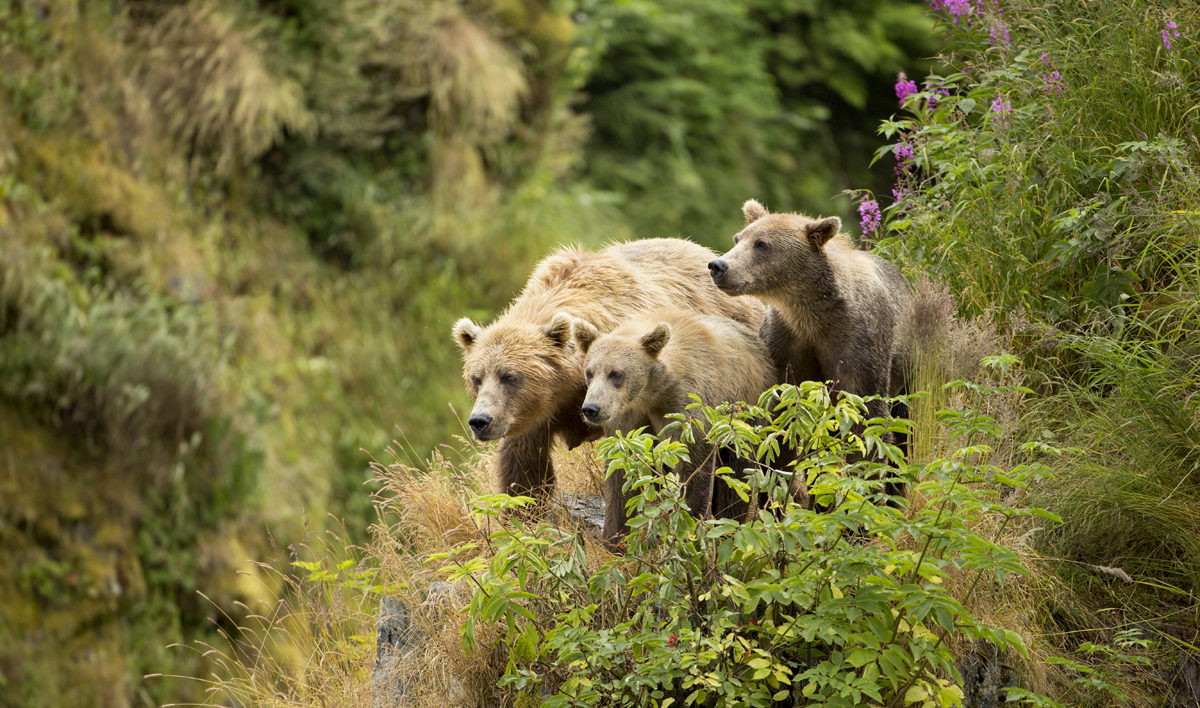Brown bears snatching salmon as they leap up waterfalls may be one of the most famous natural spectacles, familiar to anyone who has ever watched nature documentaries.
Huge salmon runs feed Alaskan brown bears (a subspecies of grizzly bear) and, indeed, an entire ecosystem. Conservationists have long recognized that brown bears need lots and lots of salmon. It’s the abundance that shapes the ecosystem. And all that’s true.
But it’s not the whole story, according to a new paper published in the journal Ecosphere. The research found that the variation in timing of salmon migrations within individual streams influenced landscape-level patterns of brown bear activity. Looking at streams on Alaska’s Kodiak Island, the researchers found that the varied timing of salmon migrations likely matters as much as abundance.
To understand the findings, let’s take a look at how salmon ecosystems function.

A Moveable Feast
Watching a nature program, you might get the idea that salmon migrate en masse, with all the fish surging upriver in one glorious spawning run. The reality is more complex. Sockeye salmon make their spawning runs at different times up different rivers and streams. That’s probably not too surprising.
Previous research found that this variance in migration timing among streams matters a lot to brown bears and other wildlife that feed on salmon. When a salmon spawning run occurs on an individual stream, bears find a feast of almost unimaginable proportions.
I once walked along an Alaskan river where a bear had passed in the night. Its trail was lined with salmon, each with a large bite taken out of it. One could imagine the bear walking down a buffet line, casually sampling each platter. The bear didn’t have to devour the whole salmon; there were so many it could munch as it walked, a moveable feast.
On Connecticut Creek, a key stream in the new paper’s study area, researchers could often see nearly 100 bears from a vantage point.

This is the abundance that makes Alaska’s salmon runs famous. “When there’s a sockeye salmon run on Kodiak Island, bears are pretty much overwhelmed with abundance,” says William Deacy, lead author of the paper and postdoctoral researcher with Oregon State’s Department of Fisheries and Wildlife. “There is more salmon than they can eat.”
As such, the bear feasts for as long as it can while the salmon spawn, but it doesn’t last forever. You might be stuffed after gorging on Thanksgiving dinner, and you might imagine that you can’t eat another bite. But the next evening, you will be hungry again. If the refrigerator’s empty, it doesn’t matter that you ate too much yesterday. You will need to go to the grocery store. It’s the same for bears. They might be stuffed after a salmon run, but after its conclusion they will need to find the next source of food.
Since salmon migrate at different times in different streams, in a healthy ecosystem brown bears can move the next valley or drainage over and find another salmon feast. Previous research has emphasized this importance of varied salmon spawning times across an ecosystem.

Complexity and Abundance
The new paper in Ecosphere, though, found that it is not just the variance across streams in an ecosystem that matters for bears, but also the variance within an individual stream. “In some streams, most of the salmon enter the stream at the same time,” says Deacy. “The entire spawning run might last several weeks. In other streams, salmon trickle in over a period of time, and there can be spawning salmon in those streams for more than two months.”
Researchers found that salmon spawning durations of creeks in the study area varied from 22 days from 72 days. They found that the amount of time bears spent at a given stream closely matched the time that salmon were spawning.
“If a bear only has salmon available for two weeks, it will need to move on fairly quickly,” says Deacy. “If the salmon are abundant for two months, it will stay put.”
Staying put likely benefits the bear. It doesn’t have to spend energy walking and climbing over mountains to move to another salmon run. It is less likely to run into conflict with a new bear, as it does when it’s roaming around. This is particularly important for females with cubs, who are risk of being killed by unfamiliar male bears.

The bottom line is that bears rely on both the variance of salmon migrations within an individual stream, as well as the variation among many streams in a given landscape. The researchers write that bears “surf the salmon wave” following the abundance of food from stream to stream. Deacy notes that by this “surfing,” some bears on Kodiak feed on salmon for 120 days in a given year.
For conservationists, there’s an important message: It’s not just about numbers of salmon. In many rivers, the solution to a loss of salmon is to attempt to replace those stocks with hatchery fish. But just producing more and more hatchery fish cannot possibly replace the complexity of a healthy salmon ecosystem.
“These salmon evolved different migration patterns, and that can’t be replaced by simply pumping out hatchery fish,” says Deacy. “It’s essentially impossible to replace that diversity once it’s lost. I know it’s a truism, but it’s a lot easier to protect what we have than to try to restore it when it’s lost. Research like this shows that brown bears depend on the complexity of salmon runs to make a living.”




Join the Discussion